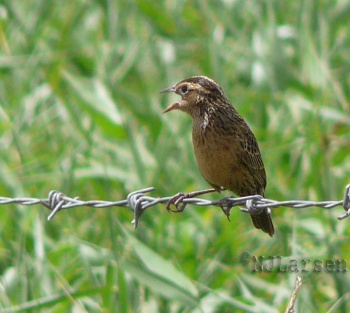Alternative name: Red-breasted Meadowlark
- Leistes militaris
Identification
18-19 cm (7-7½ in)
Male
- Black head and upperparts
- Crimson red chin, throat and breast
The females and young have more brown and much less red on their breast.
Distribution
Central and South America: found from Costa Rica south to Peru and Bolivia, and east to Trinidad, the Guianas, and Brazil.
Taxonomy
This is a monotypic species.
White-browed Blackbird has sometimes been considered conspecific with this species.
This species has formerly been placed in the genus Sturnella.
The name Red-breasted Blackbird has also sometimes been used (incorrectly) for Pampas Meadowlark.
Habitat
The males can be seen and heard singing on large wet fields with long grass or on cemeteries, ricefields and on the grass savannas.
Behaviour
Breeding
As with many birds in this family (for instance the caciques and oropendolas) the males can have more then one female. He will sing in his territory and chase away other males. Sometimes the male will fly up singing and fall back to the ground. The females take care of the breeding in nests, that can be found on the ground. The blackbirds (outside the breeding season) fly around in larger numbers (dozens) when they go to sleep together.
A deep, grass-lined open cup shaped nest is built on the ground amongst tall grasses; often several nests will be found close together. The normal clutch is two to four reddish brown-blotched cream eggs.
Diet
A ground feeder, their diet consists mostly of insects and some seeds.
Gallery
Click on photo for larger image
References
- Clements, J. F., T. S. Schulenberg, M. J. Iliff, S. M. Billerman, T. A. Fredericks, J. A. Gerbracht, D. Lepage, B. L. Sullivan, and C. L. Wood. 2021. The eBird/Clements checklist of Birds of the World: v2021. Downloaded from https://www.birds.cornell.edu/clementschecklist/download/
- Handbook of the Birds of the World Alive (retrieved August 2016)
Recommended Citation
- BirdForum Opus contributors. (2025) Red-breasted Blackbird. In: BirdForum, the forum for wild birds and birding. Retrieved 24 April 2025 from https://www.birdforum.net/opus/Red-breasted_Blackbird








